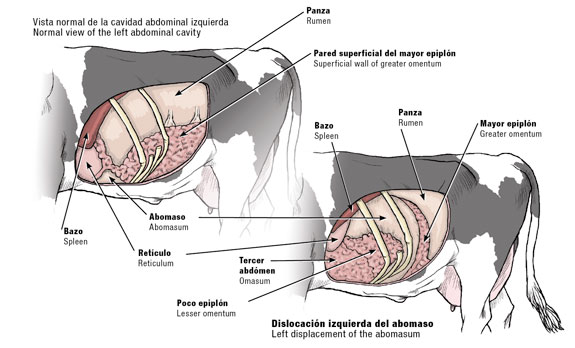The abomasum normally lies on the floor of the abdomen, but can become filled with gas and rise to the top of the abdomen when it is said to be ‘displaced’.
The precise cause of a displaced abomasums is not really understood, but two main risk factors have been implicated:
Calving – the majority of cases occur soon after calving. During pregnancy the uterus displaces the abomasum so that after calving the abomasums has to move back to its normal position, increasing the risk of displacement.
Abomasum function – If the abomasums stops contracting and turning over its contents, accumulation of gas will occur and the abomasums will tend to move up the abdomen.
In either left or right abomasal displacement, the entrance and exit to the stomach are slightly kinked. The kinks, together with the gas and fluid distension, slow food passage to a slower-than-normal rate. The symptoms seen in the cow are usually dullness, reduced feed intake, especially of concentrates, a drastic reduction in milk yield and scanty feces either firm or diarrheic.
Prevention of displaced abomasums should be aimed at ensuring dry matter intake is maintained in early lactation:
• Ensure cattle are not too fat at calving (BCS >3.5)
• Feed high quality feeds with good quality forage
• Feed a total mixed ration as opposed to concentrates
• Ensure plenty of space at feeding sites
• Minimize changes between late dry and early lactation ration
• Prevent and promptly treat diseases such as milk fever, metritis, toxic mastitis and retained fetal membranes which can also reduce feed intake
• Maximize cow comfort, minimize stress. EL






